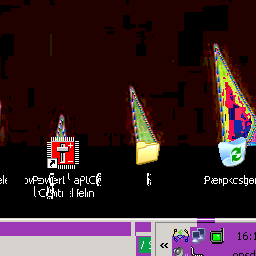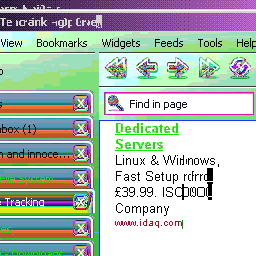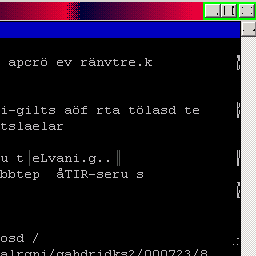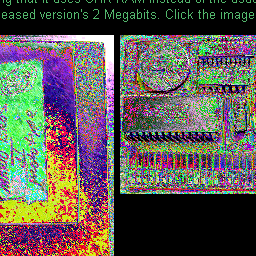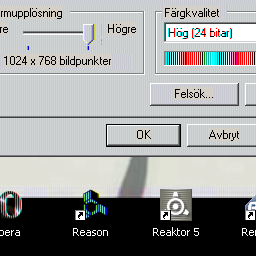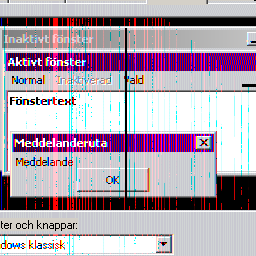Laptop frustration!
June 1st, 2007(Sorry for this super long post, but I have had some serious frustration over this thing the last week, and I needed to just let the letters flow.)
The beginning of this story takes place about one year ago. I worked as a telemarketer at a company, and looked for something in an archive room. By accident I found a Thinkpad 600E, seemingly abandoned. After a bit of nagging to the boss, he said I could keep it.
For me this was big. Even though being only a 450 MHz PII computer, this was my first laptop (Except my 386 and 486 lappies, but they have a different story, and they were not too useful in my everyday life) I invested in a wireless network card, and suddenly mr Lappy became useful for university, for writing, some surfing and simple coding. In the computer was already two network cards. both wired, of which one didn’t work. (Made the computer hang whenever a network cable was inserted)
It came with a 10 GB hard drive, which was not super big, but it was somehow sufficient for my needs back then. But one night disaster struck. I had left it on over the night, and when I woke up the next morning the screen was black. When I tried restarting it the HD just clicked a few times and then gave up. When booting a live CD, the result was that no drive could be detected. The HD was simply broken, probably an arm fell off or something.
I got a temporary drive from a friend, 6 GB, and a pinch slower than the 10 GB one. But the I decided to seriously refurbish the laptop. I invested in a PIII CPU, which I overclocked, by soldering a resistor to the clock circuit, and bypassed speedstep on the CPU by soldering a resistor there as well. It all ended up at 702 MHz.
I also bought an 80 GB HD, and replaced the 128 MB RAM in the computer by 256 MB. (For the curious: The 256 MB were found on a Sun thing which is a complete Pentium PC on a PCI board)
That happened about five months ago, and marked themarked the start of this computer’s golden era. It generated a lot of heat, but it was stable and way faster than the 450 MHz CPU that was in the computer when I found it. Even though there was some initial problems, I overcame them and the system worked well. (The only exception were occasional 108 errors, meaning timer error. I just had to turn it off/on once or twice and it’d work, so it was no big issue.)
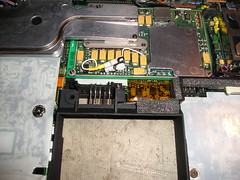
Overclocking a PIII CPU in a Thinkpad 600E
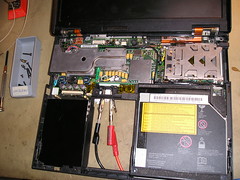
Emulating a battery to make the computer start at all during troubleshooting
About one week ago something happened that marked the end of the golden era for my Thinkpad 600E. By now, the battery life had been heavily reduced, and the battery would typicaly last for only 10 minutes or so before giving up, and my TP power adapter was suffering from loose contacts at both ends of the wire, in other words you had to wiggle the cable around at two places in order to get it right. All this wiggling of course led to more damage on the cable, until the situation was unbearable. This was supposed to be no problem, since I had an adjustable voltage supply that could easily replace the original TP adapter. That day I was going to present a piece of homework, some assembler code for the NIOS-2 CPU. I thought reliabilitym would be a good thing for this presentation, so I packed down my secondary power supply.
Before plugging it in, I double checked the voltage and polarity, but somehow I still got the polarity wrong. I don’t know how I could just miss it, but I did. Suddenly I felt the familiar fume of burnt electronics.
It seemed as if the switching regulator in the computer was destroyed. (It still ran fine on batteries) After doing an initial check for exploded caps, obviously burnt out IC’s or blown fuses, I came to the conclusion that this is beyond my skill of fixing.
So, I went back to the store where I bought the 80 GB HD. I had seen a pile of laptop junk there, and even one or two 600E’s. One was cheaper, (Corresponding US$50) but was partially broken according to the guy in the shop. I thought the error messages looked fixable, so I paid for it and walked away.
Unfortunately, i was wrong. The computer could appearantly not sense the CMOS battery. I got the errors 161 and 163, CMOS data lost and time/date not set, respectively. After setting the date, I got a OFF->ON message, meaning that I was supposed to power cycle the laptop. If it had been working properly, it had continued to boot by then. Instead I ended up with the same error, when turning the power on again. Normally this indicates a drained battery, however not in this case. The battery was fine, my voltmeter and other Thinkpad agreed on that.
So I went back to the shop and demanded to get a refund or a replacement. At first he just violently refused. He insulted me, accused me of being a liar and having tampered with the computer. Well, I actually “tampered” with it when I instaled the new CPU. But that was definitely not the cause of the problem. I even saw the error in the shop when testing it before buying it, just that I thought I could fix it.
After a lot of discussion, he accepted to replace the broken computer with the other 600E he had in stock. I carefully tested it before leaving, and it booted up ok. It had a minor display error; the display had a slight red tint, which vanished in seconds as the monitor warmed up.
Finally I thought everything was alright. I was even delighted to see that he had forgotten a dual function network/modem card in PC ard slot. I inserted the CPU, soldered the overclock resistor in place, inserted the HD and booted it up.
At first the HD wasn’t recognized, but I just needed to upgrade the Easy setup (IBM’s horrible version of a BIOS) Btw, this was done by burning floppy image to a bootable CD-ROM. If there’s interest in it, I can make that CD image available.
Then it worked like a charm. The network card was immediately detected, the screen sememd a bit brighter than on the one with a broken power regulator and the overall speed seemed higher than before.
I was at peace. Finally I got my laptop back.
The joy didn’t last for long, however. Suddenly it just crashed, for no appearant reason. After a bit of error seeking I tracked down the error to the PC card slots. Inserting anything into the slots would at best make the OS not detect the hardware correctly, and at worst bluescreen or segfault.
But never just detect it and work.
I’ve tried driver fiddling, booting live CD’s to see if something happens differently, resetting CMOS by unplugging the battery, doing the Easy setup upgrade routine once more, just to make sure.
The only two things I can think of now are:
1) that the overclock resistor might be positioned in such a way that it interferes with the PC card controller. However, this seems farfetched, since the resistor was placed the ame way in the original TP as well, without ever causing these kinds of problems. I’ll move it a bit and see if there’s a change, but that’s probably not it.
2) that the damage was caused by a glitch in the power net. This doesn’t match timewise, however. About an hour after the error happened, there was a short voltage drop of a few milliseconds. If there had been one right before the error happened, I would’ve noticed. Besides, I don’t see how a power dip could cause problems, like a power surge can.
Also, I don’t see how the error could’ve attacked only the cardbus controller. The two thing that were connected at the time was power and network. If it had come through the power supply, the CPU would definitely have been damaged first. If it had come through the netword, my router and the network card would’ve been damage in the first place. So I conclude that neither of these things are likely causes.
I’m starting to edge out about this. It’s almost as if I’m destined to not have a working laptop.
And the irony is that I was thinking two thing earlier today:
1) LOL, I wonder what hidden errors this one has.
2) Damnit, I can’t concentrate on music making if I have internet access on the same computer.
Seems like I got my “wishes” fulfilled. so now I’ll try to fix the error if possible, otherwise I’ll just use it as a music computer. (Might actually help my keep my focus on the music)
The only problem is that I got limited backup possibilities. Copying a few wave files to a memory stick works ok. (Even though it’s a USB1 connection) But, I also have about 50 GB of other data that I want to back up. However, at least I backed up my whole soUnd folder (Yes, I spell the folder name with a capital U) before I destroyed the first TP with the wrong polarity.
if there are any news, I’ll post about it here.
In the position I am now, I’m almost considering setting up a paypal donate button and try to beg for some money from my readers. But neh, you probably wouldn’t donate anyway.
Comments disabled for now due to spam
Glitched IBM Thinkpad 600E
April 25th, 2007I have a Thinkpad 600E that I inherited from my boss when I worked as a telephone salesperson. (Not my kind of job, btw) I’ve spent some time and money on upgrading and refurbishing it. What was once a 400 MHz PII with 64 MB RAM and a 6 Gb HD is now a 702 MHz PIII with 288 MB RAM and a 80 Gb HD. (Actually overclocked twice, which I did by soldering wires onto SMD components. Tricky work.)
To some people’s standards it may be slow, but it works fine for me.
But something that annoys me is that every 2-3 months or so, the graphics chip goes crazy and totally glitches out. Even after rebooting, the image still gets glitched. The only thing that seems to work is to change the graphics driver, and then change it back.
So getting rid of the glitch mode is easy. However, enterring it is not. I have yet to find out a way to summon the glitch mode. I find some of the things it does to my graphics pretty nice, and I’d like to be able to control it and use it as an image processing effect. (You can take screenshots of the glitches, which indicates that the glitched data is somehow written back to the video memory.)
Glitches happen spontaneously, as well as when moving windows, or even just the mouse pointer. (Which makes it possible to glitchify areas of the screen)
One of the reasons I’m bringing this up now, is because of a recent discussion on the benders yahoo group. (A mailing list for circuit benders) Jeremy of cutthroatfreaksshow had bought an LG Fusic camphone, which had appearantly bent itself. All images were pink-and-white instead of colored. Here are some of them. (Interestingly enough, pink seems to be a key color for my 600E as well)
An even more interesting glitched camera is owned Farrell Eaves. (Read article on LJWorld)
Back to my computer. When in glitch mode, the computer reacts differently depending on the color depth in use. If using a depth of 16 bpp, the glitches are more aggressive, so to speak, and there’s a lot of color burn kind-of effects, and text printed on the screen is heavily affected. When in 24 bpp mode, the glitches are often more subtle. This mode can produce some more subtle dirty effects. These effects remind a little of those used by NiN in their viral marketing campaign, and I find them visually appealing. (One of NiN’s sites)
’nuff said, here are the pictures:
Oh yeah, Limewire? No thank you, it’s probably one of the worst p2p clients I’ve used. Eats memory and CPU, and on top of that it has crap results. It’s just there because I was convinced by a friend to try it.
![You suck at protoshop. No, you [i]really[/i] oo.](http://blog.gg8.se/images/you-suck-at-photoshop-you-really-do-your-awful.png)




